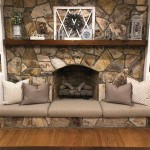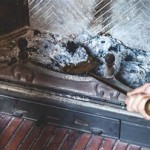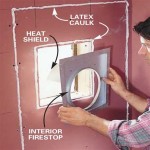Understanding the Raised Hearth Fireplace: Design, Benefits, and Considerations
The raised hearth fireplace presents a significant variation from the traditional, floor-level fireplace. Its elevated platform offers distinct aesthetic and functional advantages, making it a popular choice for contemporary and traditional homes alike. This article will explore the key features, benefits, and design considerations associated with raised hearth fireplaces.
A raised hearth, by definition, is a hearth that is elevated above the surrounding floor level. This elevation can range from a modest few inches to a more substantial height, creating a noticeable visual statement. The raised platform is typically constructed from brick, stone, concrete, or other fire-resistant materials, ensuring safety and durability. The height of the hearth is a crucial design element that influences both the aesthetics and functionality of the fireplace.
The primary motivation for choosing a raised hearth often stems from its aesthetic appeal. The elevated hearth immediately draws the eye, creating a focal point in the room. The added height can provide a sense of grandeur and sophistication, particularly in rooms with high ceilings or open floor plans. Furthermore, the raised platform offers an opportunity to incorporate decorative elements, such as accent tiles, intricate brickwork, or custom stonework, further enhancing the fireplace's visual impact.
Beyond aesthetics, the raised hearth also offers practical benefits. The elevated hearth can make tending to the fire easier and more comfortable. Eliminating the need to bend or kneel when adding wood or adjusting the fire can be particularly advantageous for individuals with mobility limitations. The raised platform also helps to contain embers and ash, reducing the risk of spills and making cleanup more manageable. In homes with small children or pets, the raised hearth can provide an extra layer of safety by making it more difficult for them to access the fire.
Aesthetic Advantages of a Raised Hearth Fireplace
The aesthetic advantages of a raised hearth fireplace are multifaceted, contributing to the overall ambiance and design of a living space. Several key elements contribute to its visual appeal.
First, the raised hearth creates a distinct focal point. In a room where the fireplace is intended as the central visual element, elevating the hearth amplifies its presence. The eye is naturally drawn upwards, emphasizing the fireplace as a prominent feature. This focused attention can be particularly effective in minimizing other potentially distracting elements within the room.
Second, the raised platform allows for the incorporation of diverse design elements. The surface of the hearth can be customized with a variety of materials, colors, and textures to complement the surrounding décor. Brick, stone, tile, and even polished concrete can be used to create a unique and visually appealing surface. The choice of materials can be tailored to match the style of the home, whether it be traditional, modern, rustic, or contemporary.
Third, the height of the raised hearth can create a sense of proportion and balance within the room. In rooms with high ceilings, a raised hearth can help to fill the vertical space and prevent the fireplace from appearing diminutive. In smaller rooms, a moderately raised hearth can add visual interest without overwhelming the space. The specific height should be carefully considered in relation to the overall dimensions of the room and the size of the fireplace itself.
Fourth, a raised hearth can visually separate the fireplace from the surrounding floor, creating a sense of definition and order. This separation can be particularly useful in open floor plans, where the fireplace serves as a visual anchor within a larger, more amorphous space. The raised platform helps to delineate the fireplace area and create a sense of intimacy and warmth.
Finally, the raised hearth can be used to showcase decorative objects, such as candles, vases, or artwork. The platform provides a convenient and visually appealing display surface, allowing homeowners to personalize the fireplace and express their individual style. The added height makes these decorative elements more visible and prominent, enhancing their overall impact.
Functional Benefits of an Elevated Fireplace Hearth
Beyond its aesthetic contributions, a raised hearth fireplace offers significant practical advantages that enhance usability and safety. These functional benefits are crucial considerations for homeowners seeking to maximize the value of their fireplace.
One of the primary functional benefits is improved ergonomics. The elevated hearth reduces the need to bend or kneel when tending to the fire. This is particularly beneficial for individuals with back pain, limited mobility, or other physical limitations. The raised platform makes it easier to add wood, adjust the damper, or clean the firebox, without straining the body. This improved accessibility contributes to a more comfortable and enjoyable experience.
Another significant benefit is enhanced safety. The raised hearth provides a physical barrier that helps to contain embers and ash. This reduces the risk of sparks escaping and igniting nearby materials, such as carpets, furniture, or drapes. The elevated platform also makes it more difficult for small children and pets to access the fire, reducing the risk of accidental burns or injuries. The added height provides an extra layer of protection, particularly in homes with young families or furry companions.
Improved air circulation is another advantage. The raised hearth can help to improve the flow of air around the firebox, promoting more efficient combustion. This can result in a hotter, more consistent fire, which generates more heat for the room. Efficient combustion also reduces the amount of smoke and pollutants released into the air, contributing to a healthier indoor environment. The raised platform allows for better airflow underneath the firebox, which can further enhance combustion efficiency.
Ease of cleaning is another practical benefit. The raised hearth makes it easier to clean up spills and debris around the fireplace. The elevated platform prevents ash and embers from spreading onto the surrounding floor, making cleanup more contained and manageable. The smooth surface of the hearth can be easily wiped down with a damp cloth or vacuumed, keeping the area clean and tidy. The raised platform also makes it easier to access the firebox and clean out accumulated ash.
Finally, the raised hearth can serve as a functional seating area. Depending on its size and design, the raised platform can provide a convenient place to sit and warm oneself by the fire. This is particularly useful in smaller rooms where seating space is limited. The raised hearth can be equipped with cushions or pillows to enhance comfort, creating a cozy and inviting space to relax and enjoy the warmth of the fire.
Design Considerations for Incorporating a Raised Hearth
Successfully incorporating a raised hearth into a fireplace design requires careful consideration of several key factors. These design considerations ensure that the raised hearth complements the existing architecture and meets the specific needs of the homeowner.
The first consideration is the height of the raised hearth. The height should be proportionate to the size of the room and the dimensions of the fireplace. A hearth that is too high can appear overwhelming, while a hearth that is too low may not provide the desired visual impact or functional benefits. Consider the height of existing furniture and the sightlines within the room to determine the optimal height for the raised hearth. As a general guideline, a hearth height of 12 to 18 inches is often a good starting point, but this can be adjusted based on individual preferences and the specific characteristics of the space.
The choice of materials is another crucial consideration. The materials used for the raised hearth should be fire-resistant and durable, as well as aesthetically pleasing. Brick, stone, concrete, and tile are all common choices. The specific material should be selected to complement the style of the home and the overall design of the fireplace. Consider the color, texture, and pattern of the materials to create a cohesive and visually appealing design. It is also important to ensure that the materials are easy to clean and maintain.
The shape of the raised hearth is another important design element. The hearth can be rectangular, square, curved, or even custom-shaped to fit the specific dimensions of the room and the desired aesthetic. A rectangular or square hearth is a classic and versatile choice, while a curved hearth can add a touch of elegance and sophistication. Consider the overall shape of the fireplace and the surrounding architecture when determining the shape of the raised hearth. It is also important to ensure that the shape of the hearth does not obstruct traffic flow or create any safety hazards.
Integrating the raised hearth with the surrounding décor is essential. The raised hearth should blend seamlessly with the existing style of the room and complement the overall design scheme. Consider the colors, textures, and patterns used in the room when selecting materials and finishes for the raised hearth. It is also important to ensure that the raised hearth does not clash with any existing architectural features or furniture. The goal is to create a cohesive and harmonious design that enhances the overall ambiance of the space.
Finally, consider the placement of the raised hearth within the room. The ideal location for the fireplace and raised hearth will depend on the layout of the room and the desired focal point. The fireplace should be placed in a location that maximizes its visual impact and provides adequate space for seating and circulation. Consider the location of windows, doors, and other architectural features when determining the placement of the fireplace. It is also important to ensure that the fireplace is properly vented and that the chimney meets all applicable building codes.

Raised Hearth Design Ideas

Traditional Fireplace With Raised Hearth Photos Ideas Houzz

Stone Hearth Fireplace Old World Stoneworks

Fireplace With Raised Hearth Photos Ideas Houzz

How To Build A Raised Fireplace Hearth Design

Fireplace Makeovers With Raised Hearth Home Remodel Seating

French Gothique Fire Surround Solid Raised Hearth With Rose Carving To Lintel Touch Fireplace Designs The Natural Stone Co

Traditional Fireplace With Raised Hearth Photos Ideas Houzz

Diy Fireplace Makeover At Home With The Barkers

Raised Fireplace Hearth Design Ideas
Related Posts








